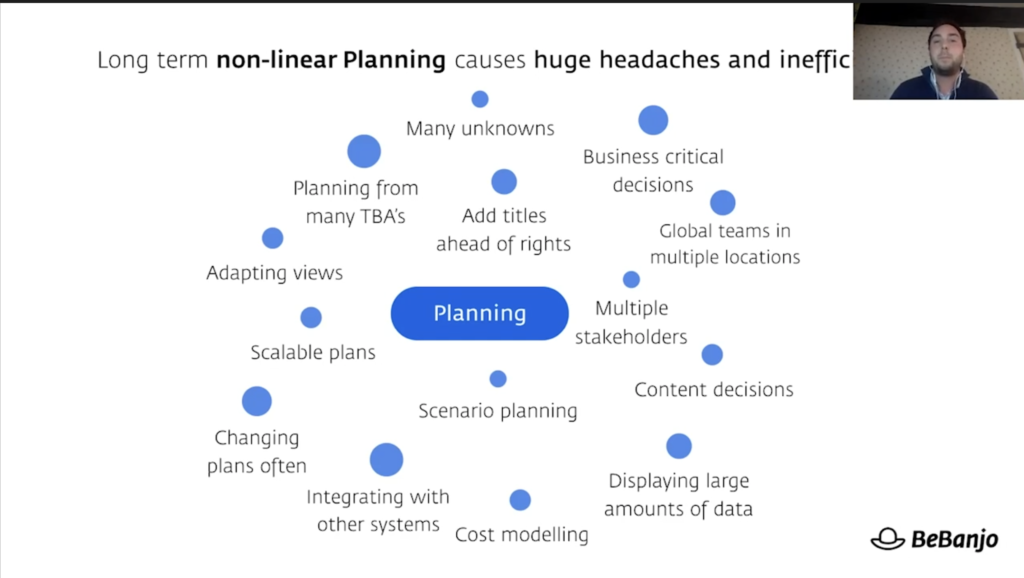M+E Daily

BeBanjo: Optimizing the Non-Linear Planning Process is a Key to Success
Story Highlights
One element that can help broadcasters, telco’s and over-the-top (OTT) operators compete is optimizing their non-linear planning processes, which provides a long-term strategic advantage in content planning, according to Dan Meyer, sales manager at BeBanjo.
“In the last few years, as competition has increased and the rewards for success have become greater, those of you who are distributing premium TV and film content online need to focus more and more on many different areas of your business,” he said during the Consumers & Analytics breakout session “Reimagining the Non-Linear Planning Process for Success!” at the March 16 Smart Content Summit.
“Those streaming services that have mastered this are reaping the benefits, whereas those who haven’t quite mastered this are more and more likely to struggle to grow efficiently and effectively,” he told viewers.
 It is often “overlooked that the ability to plan content efficiently and effectively, as well as communicate both internally within your teams and externally to your customers, will be a key factor in your success over the next few years as competition again becomes even more fierce and everyone looks for that long-term, sustainable success,” he explained.
It is often “overlooked that the ability to plan content efficiently and effectively, as well as communicate both internally within your teams and externally to your customers, will be a key factor in your success over the next few years as competition again becomes even more fierce and everyone looks for that long-term, sustainable success,” he explained.
Clear and efficient planning of non-linear content is going to play a role in achieving that success, he said, noting BeBanjo is working with some of its customers to achieve this.
“We’re focusing on non-linear planning today but also we focus on short-term scheduling,” he said, explaining that planning and scheduling determines which piece of content is going on which platform and which territory and when.
BeBanjo helps its customers “drive efficiencies, further exploit their existing catalog of content, and help them look for new revenue streams, helping them to be successful now and also in the future,” he pointed out.
What a Successful Streaming Service Is
“It doesn’t matter if you’re measuring AVOD revenue, TVOD revenue, subscriber growth or whatever else it might be as your metric for success,” according to Meyer.
“To get there, it’s almost certain that you are spending millions and probably billions of dollars on content and marketing,” he noted, adding: “The key aims of a successful business are growing more subscribers or viewers and retaining those subscribers or viewers for long-term predictability of your business. And this is becoming more and more important as operators, broadcasters and streaming services pivot more to streaming.”
An organization’s content and marketing “will likely grow short-term success but for success and growth to be sustainable in the long-term it’s also important to look at other areas to drive efficiencies internally,” he said. “To do this, we’ve seen that having very efficient non-linear planning as well as operations are key to this success as well.”
Potential Headaches
It is “quite clear from our conversations we have and what we’ve seen in the market over many, many years [that] taking action to improve the planning process is often really only focused [when] things start to go wrong,” Meyer pointed out.
And how does an organization know things are going wrong? “If you see issues in scaling efficiently, you have many issues launching new platforms or expanding to new territories,” Meyer said, explaining:
 “This is when the focus really becomes planning operations. But leaving these decisions until the last minute could have a large negative impact on your business both internally and externally…. Internally, your teams will be over-stretched and manage all their operations in inefficient ways and, externally, your customers will notice this and could go elsewhere as that competition increases.”
“This is when the focus really becomes planning operations. But leaving these decisions until the last minute could have a large negative impact on your business both internally and externally…. Internally, your teams will be over-stretched and manage all their operations in inefficient ways and, externally, your customers will notice this and could go elsewhere as that competition increases.”
“There are many, many headaches” that poor planning “can cause,” he told viewers. The most common ones seen today include the fact that an organization’s planning process is “often rudimental at best,” he said, explaining: “Long-range planning is done potentially on physical white boards [or] walls with sticky labels and other forms of office place planning. Although this provides a practical approach to those who work in the same office, the likes of the current pandemic, regional and international operations and remote teams make this approach incredibly inefficient. For one, these plans just simply cannot be shared easily.”
One alternative that is used by some organizations is “one we are all familiar with and we all probably use on an everyday basis” and that is Excel, he noted. However, that system also has its drawbacks, he said, adding: “Sharing versions and real-time collaboration is different [and] long-term planning over multiple years isn’t easy using such a tool. Another downside is being able to integrate with other systems as part of the workflow to drive those efficiencies and data sharing across the organization.” It can cause delays in workflow and can create “inconsistencies that just should be avoided in the planning process.”
Meanwhile, “planning by its nature involves many unknowns,” he pointed out, explaining: “It involves multiple stakeholders. It involves making those million- and billion-dollar decisions on content and doing this with inefficient tools is unsustainable in the long-term.”
What is at the heart of “long-term or strategic planning is mixing existing titles with your existing catalog and looking at which content you should acquire and commission,” he said. And this should be “set up in optimal way to meet your objectives internally, to meet your company’s overall ambitions, to take into account constraints you might have within the business and also look at your consumers’ demands,” he noted, adding it “should all be encompassed within some kind of planning solution.”
Additional Challenges
Other challenges that BeBanjo sees include: Scenario planning that involves simulating different scenarios based on an organization’s target reach and cost, [and] processing metadata and collecting it from multiple… areas of your business,” Meyer told viewers.
“Viewing the shorter-range plans and longer-range plans in one easy-to-use tool is also very difficult [and] there’s also a lack of overview to determine certain title genres,” he noted, adding: “These systems usually rely on tasks being completed in a consecutive manner and this creates pressure at the end of a cycle and results in peaks… of activity for your teams, which also makes your teams find it very hard to process this. This is made even worse with teams working in different departments and different regions and using disjointed operational tools.”
It is “not anyone’s fault that this is the way it is,” he noted. “It’s a result of years of growth” and the tools that have been purchased over those years “that now don’t fit the needs of a fully-fledged international streaming business.”
 What Successful Non-Linear Planning Looks Like
What Successful Non-Linear Planning Looks Like
“We often see companies focusing on the content and marketing, which they should of course,” Meyer said. “But we also believe that these aren’t the only two factors which affect success, and that’s why we really believe strong tools to help with the planning and scheduling process are key for success.”
What is crucial is making the long-range planning process simple but effective to bring that sustainable growth, he noted.
Successful non-linear planning covers a horizon of six months up to five years, is done by editorial, sales and strategy teams, and involves modeling costs and scenarios, he said.
Additionally, “it’s about acquiring and commissioning content and maximizing the value of the content you have [and] a good non-linear planning solution should have great” user interfaces, he noted. It also “allows for future-proofing your tools and an organization should be able to integrate it with other systems, he said.
“There’s also potential for automating the planning and scheduling process or at least some of it, and this could be potentially great drivers for success and efficiency in the future,” he said, adding: “This is something we’re talking to several customers and potential customers about at the moment.”
BeBanjo has developed planning tools to complement its existing scheduling offering and made it available in one unified Software-as-a-service (SaaS) solution.
“We’re also introducing a system that doesn’t rely on tasks being completed consecutively” that will enable organizations using it to “remove the pressure at the end of a cycle, eliminate [the] peaks and troughs of activity, and free up your planning as well as operational teams so they can be used more efficiently across the business,” Meyer told viewers.
“What we’re trying to do is really bring the speed and flexibility of the tools you get with Excel” and combine it with the “value you get from a specialist SaaS product,” he explained.
The Smart Content Summit was produced by MESA and the Smart Content Council, and was sponsored by Microsoft Azure, Whip Media Group, Richey May Technology Solutions, BeBanjo, Digital Nirvana, Softtek, 24Notion, EIDR, The Quorum and Signiant.









